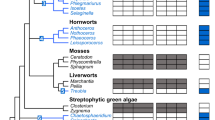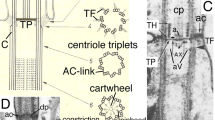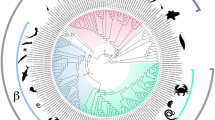Abstract
The segmented annelid worm, Mesenchytraeus solifugus, is a permanent resident of temperate, maritime glaciers in the Pacific northwestern region of North America, displaying atypically high intracellular ATP levels which have been linked to its unusual ability to thrive in hydrated glacier ice. We have shown previously that ice worms contain a highly basic, carboxy terminal extension on their ATP6 regulatory subunit, likely acquired by horizontal gene transfer from a microbial dietary source. Here we examine the full complement of F1F0 ATP synthase structural subunits with attention to non-conservative, ice worm-specific structural modifications. Our genomics analyses and molecular models identify putative proton shuttling domains on either side of the F0 hemichannel, which predictably function to enhance proton flow across the mitochondrial membrane. Other components of the ice worm ATP synthase complex have remained largely unchanged in the context of Metazoan evolution.





Similar content being viewed by others
References
Napolitano MJ, Nagele RO, Shain DH (2004) The ice worm, Mesenchytraeus solifugus, elevates adenylate nucleotides at low physiological temperature. Comp Biochem Physiol A 137:227–235
Amato P, Christner BC (2009) Energy metabolism response to low-temperature and frozen conditions in Psychrobacter cryohalolentis. Appl Environ Microbiol 75:711–718
Hanson RW (1989) The role of ATP in metabolism. Biochem Educ 17:86–92. https://doi.org/10.1016/0307-4412(89)90012-5
Kotchoni SO, Gachomo EW, Slobodenko K, Shain DH (2016) AMP DEAMINASE suppression increases biomass, cold tolerance and oil content in green algae. Algal Res 16:473–480
Morrison BA, Shain DH (2008) An AMP nucleosidase gene knockout in Escherichia coli elevates intracellular ATP levels and increases cold tolerance. Proc R Soc Lond B (Suppl) 4:53–56
Parry BR, Shain DH (2011) Manipulations of AMP metabolic genes increase growth rate and cold tolerance in Escherichia coli: implications for psychrophilic evolution. Mol Biol Evol 28:2139–2145
Boyer PD (1997) The ATP synthase—a splendid molecular machine. Ann Rev Biochem 66:717–749
Lott MT, Leipzig JN, Derbeneva O, Xie HM, Chalkia D, Sarmady M, Procaccio V, Wallace DC (2013) mtDNA variation and analysis using MITOMAP and MITOMASTER. Curr Protoc Bioinform 1(123):1–26
Lang SA, Shain DH (2018) Atypical evolution of the F1F0 ATP synthase regulatory ATP6subunit in glacier ice worms (Annelida: Clitellata: Mesenchytraeus). Evol Bioinform 14:1–4. https://doi.org/10.1177/1176934318788076
Allegretti M, Klusch N, Mills DJ, Vonck J, Kühlbrandt W, Davies KM (2015) Horizontal membrane-intrinsic α-helices in the stator a subunit of an F-type ATP synthase. Nature 521:237–240
Hahn A, Parey K, Bublitz M, Mills DJ, Zickermann V, Vonck J, Kühlbrandt W, Meier T (2016) Structure of a complete ATP synthase dimer reveals the molecular basis of inner mitochondrial membrane morphology. Mol Cell 63:445–456
Zhou A, Rohou A, Schep DG, Bason JV, Montgomery MG, Walker JE, Grigorieff N, Rubinstein JL (2015) Structure and conformational states of the bovine mitochondrial ATP synthase by cryo-EM. Elife 4:e10180
Mishmar D, Ruiz-Pesini E, Golik P, Macaulay V, Clark AG, Hosseini S et al (2003) Natural selection shaped regional mtDNA variation in humans. Proc Natl Acad Sci USA 100:171–176
Tzen CY, Wu TY, Liu HF (2001) Sequence polymorphism in the coding region of mitochondrial genome encompassing position 8389–8865. Forensic Sci Int 120:204–209
Holt IJ, Harding AE, Petty RK, Morgan-Hughes JA (1990) A new mitochondrial disease associated with mitochondrial DNA heteroplasmy. Am J Hum Genet 46:428–433
Morava E, Rodenburg RJ, Hol F et al (2006) Clinical and biochemical characteristics in patients with a high mutant load of the mitochondrial T8993G/C mutations. Am J Med Genet A 140:863–868
Tatuch Y, Robinson BH (1993) The mitochondrial DNA mutation at 8993 associated with NARP slows the rate of ATP synthesis in isolated lymphoblast mitochondria. Biochem Biophys Res Commun 192:124–128
Trounce I, Neill S, Wallace DC (8993T) Cytoplasmic transfer of the mtDNA nt 8993T–%3eG (ATP6) point mutation associated with Leigh syndrome into mtDNA-less cells demonstrates cosegregation with a decrease in state III respiration and ADP/O ratio. Proc Natl Acad Sci USA 91:8334–8338
Dionisi-Vici C, Seneca S, Zeviani M et al (1998) Fulminant Leigh syndrome and sudden unexpected death in a family with the T9176C mutation of the mitochondrial ATPase 6 gene. J Inherit Metab Dis 21:2–8
Lang SA, Saglam N, Kawash J, Shain DH (2017) Punctuated invasion of water, ice, snow and terrestrial ecozones by segmented worms (Oligochaeta: Enchytraeidae: Mesenchytraeus). Proc R Soc B 284:20171081. https://doi.org/10.1098/rspb.2017.1081
Yang Z (2007) PAML 4: a program package for phylogenetic analysis by maximum likelihood. Mol Biol Evol 24:1586–1591
Ronquist F, Teslenko M, van der Mark P, Ayres DL, Darling A, Höhna S, Larget B, Liu L, Suchard MA, Huelsenbeck JP (2012) MrBayes 3.2: efficient Bayesian phylogenetic inference and model choice across a large model space. Syst Biol 61:539–542
Guex N, Peitsch MC (1997) SWISS-MODEL and the Swiss-PdbViewer: an environment for comparative protein modeling. Electrophoresis 18:2714–2723
Studer G, Biasini M, Schwede T (2014) Assessing the local structural quality of transmembrane protein models using statistical potentials (QMEANBrane). Bioinformatics 30:i505–i511
Bernstein HJ (2000) Recent changes to RasMol, recombining the variants. Trends Biochem Sci 25:453–455
Sayle R, Milner-White EJ (1995) RasMol: Biomolecular graphics for all. Trends Biochem Sci 20:374
Napolitano MJ, Shain DH (2004) Four kingdoms on ice: convergent energetic processes boost energy levels at low physiological temperatures. Proc R Soc B (Suppl) 271:S273–S276
Nye JF (1999) Lecture notes on water in ice: microscopic and geophysical scales. In: Wettlaufer JS, Dash JG, Untersteiner N (eds) Ice physics and the natural environment. Springer, New York, pp 273–279
Feller G, Gerday C (2003) Psychrophilic enzymes: hot topics in cold adaptation. Nat Rev Microbiol 1:200–208
Siddiqui KS, Cavicchioli R (2006) Cold-adapted enzymes. Annu Rev Biochem 75:403–433
Smalas AO, Leiros HK, Os V et al (2000) Cold adapted enzymes. Biotechnol Annu Rev 6:1–57
Hotaling S, Shain DH, Lang SA, Bagley RK, Tronstad LM, Weisrock DW, Kelley JL (2019) Long-distance dispersal, ice sheet dynamics and mountaintop isolation underlie the genetic structure of glacier ice worms. Proc R Soc B 286:1905. https://doi.org/10.1098/rspb.2019.0983
Walpole TB, Palmer DN, Jiang H, Ding S, Fearnley IM, Walker JE (2015) Conservation of complete trimethylation of lysine-43 in the rotor ring of c-subunits of metazoan adenosine triphosphate (ATP) synthases. Mol Cell Proteomics 14:828–840
Walker JE (1998) ATP synthesis by rotary catalysis. Angew Chem Int Ed 37:5000–5011
Hara KY, Kato-Yamada Y, Kikuchi Y, Hisabori T, Yoshida M (2001) The role of the βDELSEED motif of F1-ATPase: propagation of the inhibitory effect of the ε subunit. J Biol Chem 276:23969–23973
Gillespie JH (1984) Molecular evolution over the mutational landscape. Evolution 38:1116–1129
Leushkin EV, Bazykin GA, Kondrashov AS (2012) Insertions and deletions trigger adaptive walks in Drosophila proteins. Proc Biol Sci 279:3075–3082
Odokonyero D, Sakai A, Patskovsky Y, Malashkevich VN, Fedorov AA, Bonanno JB, Fedorov EV, Toro R, Agarwal R, Wang C, Ozerova NDS, Yew WS, Sauder JM, Swaminathan S, Burley SK, Almo SC, Glasner ME (2014) Loss of quaternary structure is associated with rapid sequence divergence in the OSBS family. Proc Natl Acad Sci USA 111:8535–8540
Tian D, Wang Q, Zhang P, Araki H, Yang S, Kreitman M, Nagylaki T, Hudson R, Bergelson J, Chen JQ (2008) Single-nucleotide mutation rate increases close to insertions/deletions in eukaryotes. Nature 455:105–108
Zhang Z, Huang J, Wang Z, Wang L, Gao P (2011) Impact of indels on the flanking regions in structural domains. Mol Biol Evol 28:291–301
Havlíčková V, Kaplanová V, Nůsková H, Drahota Z, Houštěk J (2010) Knockdown of F(1) epsilon subunit decreases mitochondrial content of ATP synthase and leads to accumulation of subunit C. Biochim Biophys Acta 1797:1124–1129
Adams KL, Palmer JD (2003) Evolution of mitochondrial gene content: gene loss and transfer to the nucleus. Mol Phylogenet Evol 29:380–395
Selosse M-A, Albert B, Godelle B (2001) Reducing the genome size of organelles favours gene transfer to the nucleus. Trends Ecol Evol 16:135–141
Kühlbrandt W, Davies KM (2016) Rotary ATPases: a new twist to an ancient machine. Trends Biochem Sci 41:106–116
Paumard P, Vaillier J, Coulary B, Schaeffer J, Soubannier V, Mueller DM, Brèthes D, di Rago JP, Velours J (2002) The ATP synthase is involved in generating mitochondrial cristae morphology. EMBO J 21:221–230
Wittig I, Schägger H (2008) Structural organization of mitochondrial ATP synthase. Biochim Biophys Acta 1777:592–598
Nishida S, Mizuno T, Obata H (2008) Involvement of histidine-rich domain of ZIP family transporter TjZNT1 in metal ion specificity. Plant Physiol Biochem 46:601–606
Funding
This work was supported by ARRA NIH R15GM093685 and Busch grants to DHS.
Author information
Authors and Affiliations
Corresponding author
Ethics declarations
Conflict of interest
The authors declare they have no conflicts of interest.
Ethical Approval
This article does not contain any studies with human participants or animals performed by any of the authors.
Additional information
Publisher's Note
Springer Nature remains neutral with regard to jurisdictional claims in published maps and institutional affiliations.
Electronic supplementary material
Below is the link to the electronic supplementary material.
Rights and permissions
About this article
Cite this article
Lang, S.A., McIlroy, P. & Shain, D.H. Structural Evolution of the Glacier Ice Worm Fo ATP Synthase Complex. Protein J 39, 152–159 (2020). https://doi.org/10.1007/s10930-020-09889-x
Published:
Issue Date:
DOI: https://doi.org/10.1007/s10930-020-09889-x




